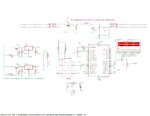MechaMark314
Newbie
I'm designing a switched-mode power supply (SMPS) buck converter which can step down 35 V to a specified value below. The output is fed back through a voltage divider which maps a maximum 35 V to 5 V into the analog channel of a PIC16F877A microcontroller. The MCU has the PID control loop program and outputs a PWM signal with a duty cycle depending on the PID calculation through a CCP pin. This PWM signal passes through a IR2112 MOSFET driver (only configured as high-side driver) with a bootstrap capacitor in order to drive the buck converter's IRF530 n-channel enhancement mode MOSFET. A LCD module is used for displaying the desired voltage value.
As many of you know, SMPS are used and prefered over linear regulators since they offer higher efficiency. The thing is that the microcontroller and the LCD require a fixed 5 V regulated supply to work, and the MOSFET driver requires 12 V. These fixed voltages are offered with a 7805 and 7812 linear regulators respectively. Also, since the input is 35 V (which come from a rectifier output of 24 Vrms through a filter capacitor) I can't feed directly the 7805 regulator else it can burn, so I used two TIP41 NPN BJTs to step down the input voltage to the linear regulators to 20-21 V. My question is: is this a good idea? Is it feasable to use a linear regulator within a buck converter (or a SMPS in general)? The schematic of my project is below.
As many of you know, SMPS are used and prefered over linear regulators since they offer higher efficiency. The thing is that the microcontroller and the LCD require a fixed 5 V regulated supply to work, and the MOSFET driver requires 12 V. These fixed voltages are offered with a 7805 and 7812 linear regulators respectively. Also, since the input is 35 V (which come from a rectifier output of 24 Vrms through a filter capacitor) I can't feed directly the 7805 regulator else it can burn, so I used two TIP41 NPN BJTs to step down the input voltage to the linear regulators to 20-21 V. My question is: is this a good idea? Is it feasable to use a linear regulator within a buck converter (or a SMPS in general)? The schematic of my project is below.
